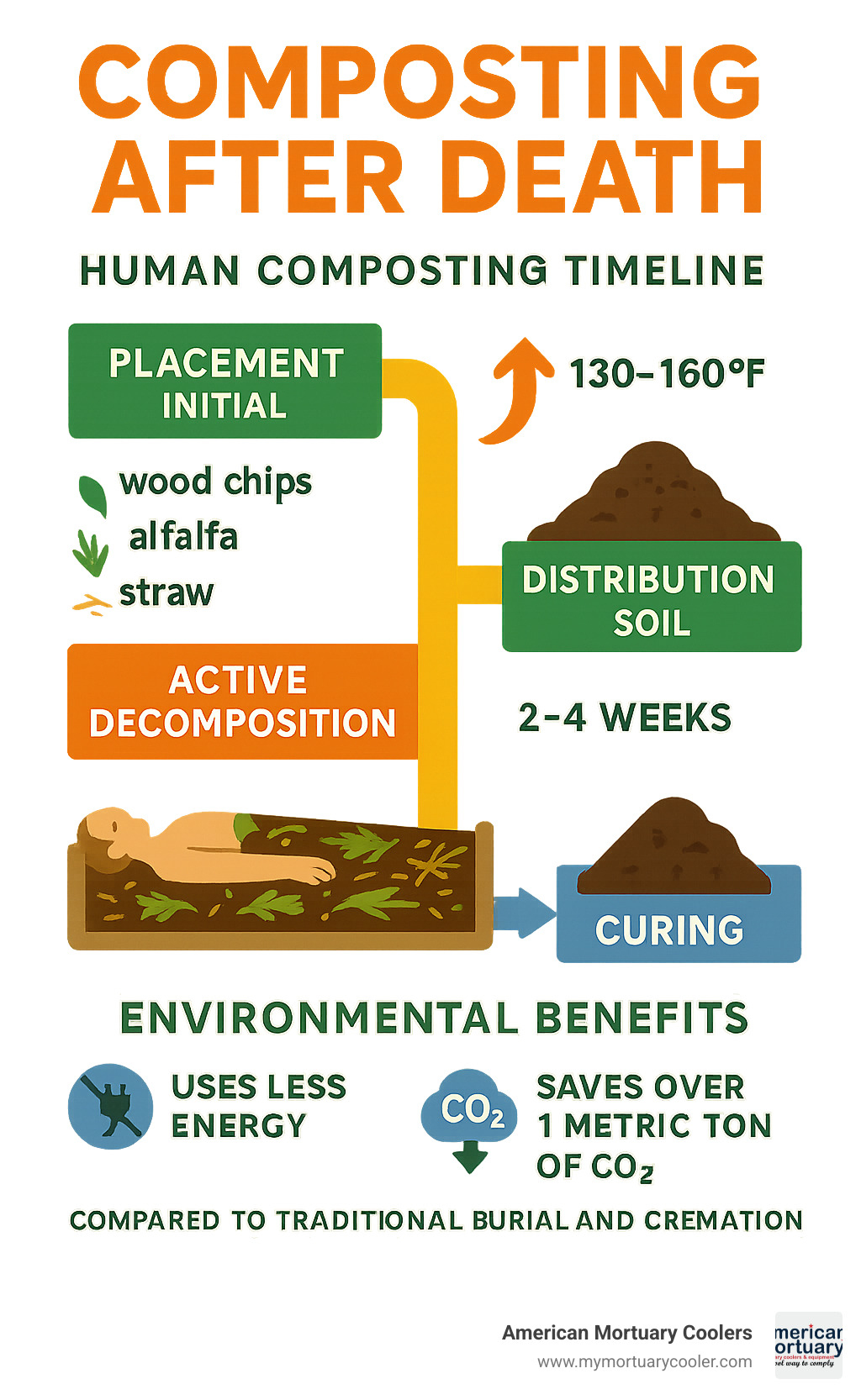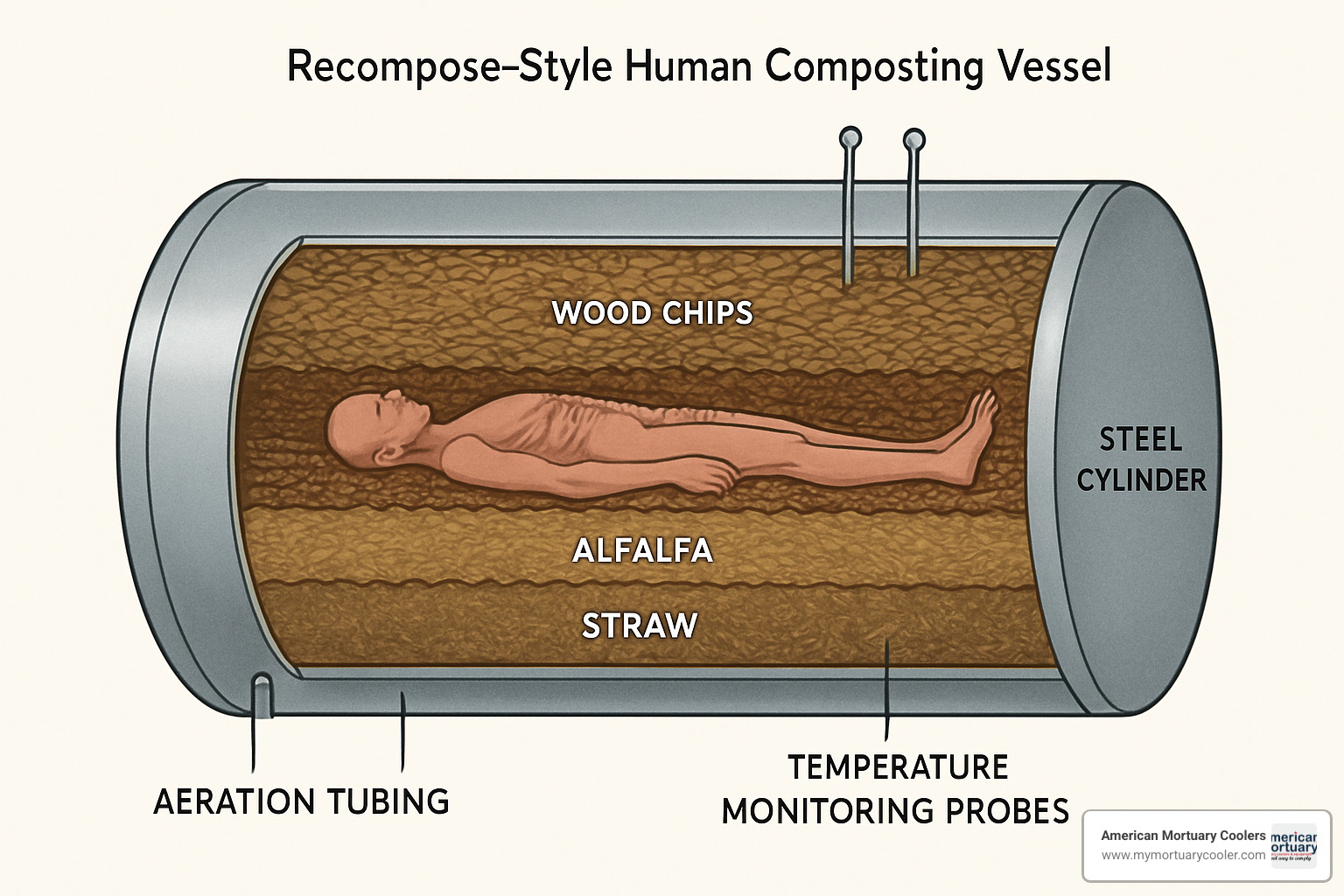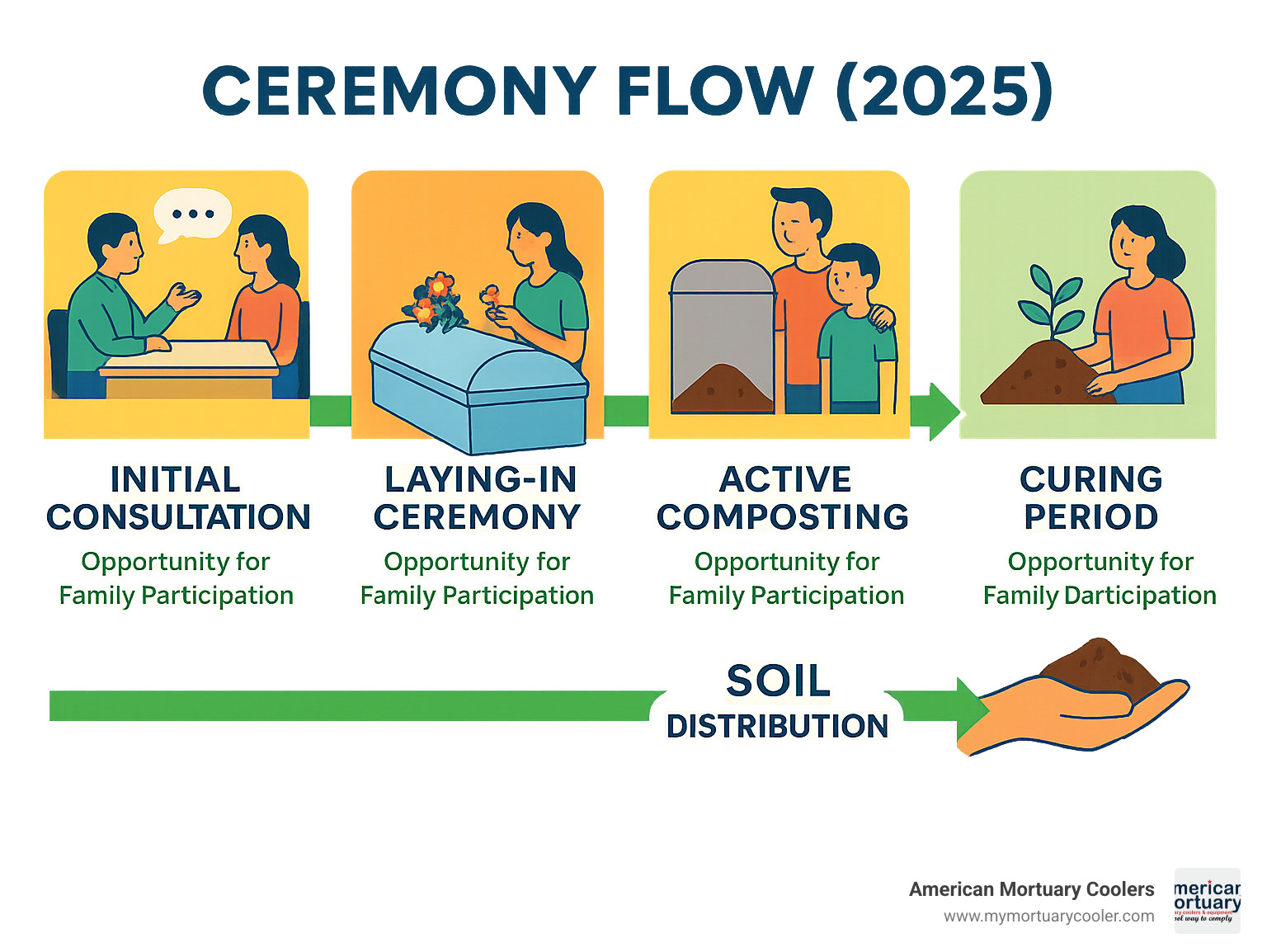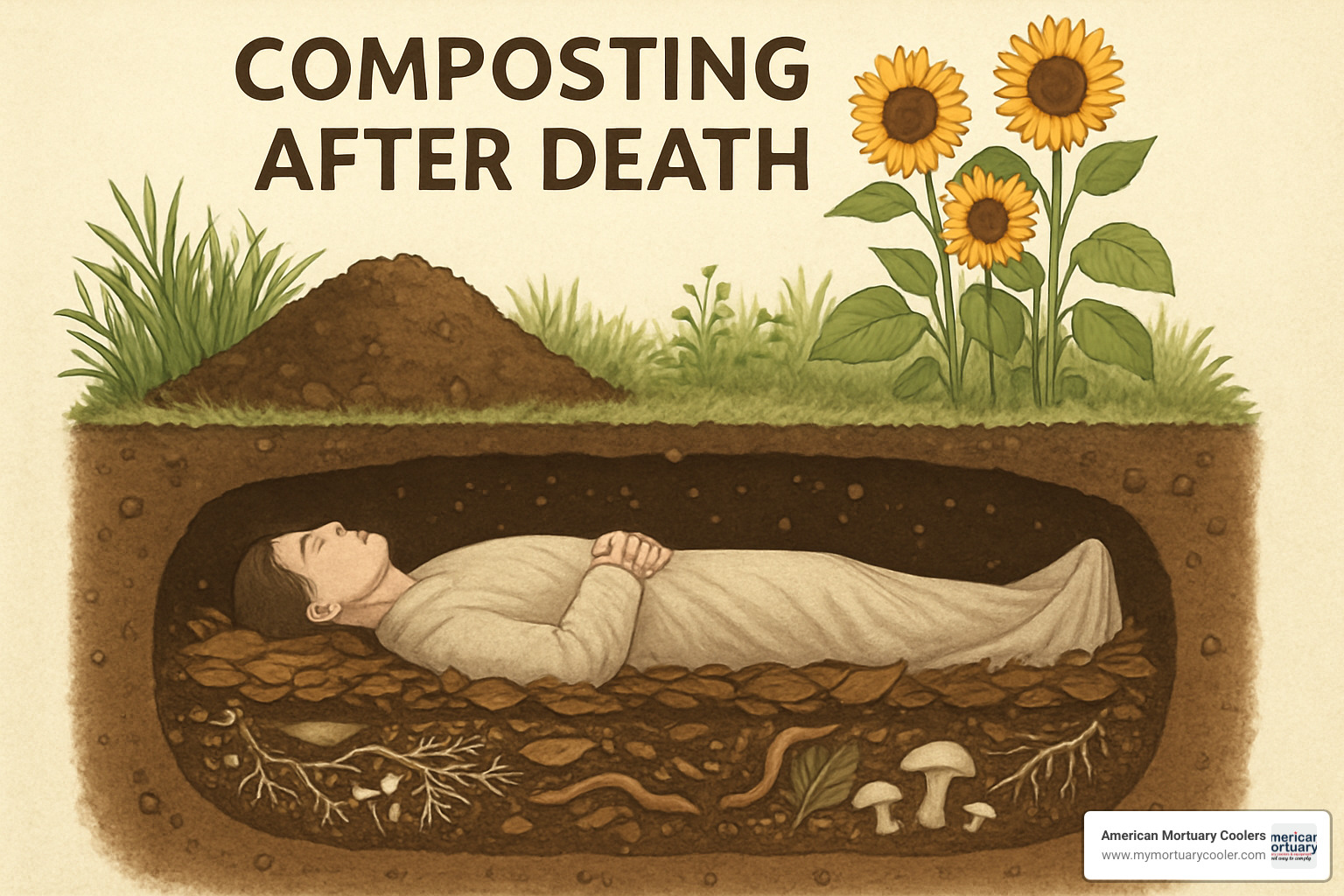
Everything You Need to Know About Composting After Death
Why Composting After Death is Changing Green Burial Options
Composting after death - also known as natural organic reduction or terramation - is a sustainable burial method that transforms human remains into nutrient-rich soil through controlled microbial decomposition. This eco-friendly alternative to traditional burial and cremation is now legal in 10+ U.S. states and growing rapidly.
Quick Facts About Human Composting:
- Process time: 4-8 weeks active composting + 2-4 weeks curing (6-12 weeks total)
- Cost: $4,000-$7,000 (comparable to cremation, less than burial)
- Output: One cubic yard of soil per body
- Energy use: 87% less than cremation
- Legal status: Available in Washington, Colorado, Oregon, California, Vermont, New York, Nevada, Arizona, Maryland, Delaware
- Environmental impact: Saves over 1 metric ton of CO₂ compared to traditional methods
The process works much like composting organic matter on a forest floor. Bodies are placed in specialized vessels with wood chips, alfalfa, and straw. Natural microbes break down the remains over several weeks at temperatures of 130-160°F. The result is pathogen-free, nutrient-rich soil that families can use for memorial gardens or donate to conservation projects.
This shift toward composting after death reflects broader environmental concerns about traditional funeral practices. Cremation produces an estimated 418 pounds of CO₂ per body, while burial uses toxic embalming chemicals and valuable land. Human composting eliminates these issues while creating something beneficial for the ecosystem.
As American Mortuary Coolers, we've worked extensively with funeral homes adapting their facilities for emerging green burial methods including composting after death. Our experience helping facilities steer new eco-friendly options has shown us how this sustainable approach is reshaping the death care industry.

Composting After Death Explained
Think of composting after death as nature's own recycling program, but with a helping hand from science. Just like how fallen leaves transform into rich soil on the forest floor, human composting - officially called natural organic reduction - uses the same natural process to turn our bodies into fertile earth.
The process goes by a few names. Some providers call it terramation, while scientists prefer natural organic reduction or NOR. Whatever you call it, the idea is beautifully simple: work with nature instead of against it.
Instead of pumping bodies full of toxic chemicals or burning them at high temperatures, composting after death lets beneficial microbes do what they do best - break down organic matter and create something useful.
The magic happens in specially designed vessels where bodies are surrounded by wood chips, alfalfa, and straw. These materials create the perfect environment for thermophilic bacteria. With the right mix of oxygen, moisture, and warmth, these tiny workers transform human remains into rich soil.
The process generates its own heat, reaching 130-160°F naturally. This temperature eliminates harmful pathogens while keeping all the good nutrients intact. No external heating required - it's all powered by natural decomposition.
After about 6-12 weeks, each body becomes roughly one cubic yard of nutrient-rich soil - enough to fill a pickup truck bed. This isn't just any dirt. It's premium compost packed with nitrogen, phosphorus, potassium, and sulfur. Perfect for helping trees and plants thrive.
Benefits of Composting After Death
The environmental benefits of composting after death are impressive. While cremation pumps out 418 pounds of CO₂ per body (equivalent to driving 470 miles), human composting uses just one-eighth of that energy.
Traditional burial practices aren't much better for the environment. Every year in the U.S., we bury bodies with over 800,000 gallons of toxic embalming chemicals. These preservatives, including formaldehyde, don't stay put - they can seep into groundwater and contaminate soil for years.
Cemeteries need constant maintenance, watering, and valuable real estate that could support natural ecosystems instead. Composting after death skips all of that while actually giving back to the environment.
The process doesn't just avoid creating pollution - it actively helps fight climate change. Each human composting captures and stores 0.84-1.4 metric tons of CO₂ in the resulting soil. That's carbon sequestration in action, pulling greenhouse gases out of the atmosphere.
Legal Status of Composting After Death
Composting after death is gaining legal ground across America. Washington state led the charge in 2019, becoming the first place in the U.S. to legalize natural organic reduction.
Since then, ten states now allow human composting, with more joining each year. Colorado and Oregon jumped on board in 2021 and 2022. Vermont said yes in 2022. New York, Nevada, Arizona, Maryland, and Delaware all approved it by 2024.
California passed legislation too, though it won't be available there until 2027. Meanwhile, states like Georgia, Illinois, and Massachusetts are considering their own bills.
Each state writes its own rules about how composting after death should work. Most require special licensing for facilities, training for operators, and regular soil testing. The Tracker map keeps tabs on which states are considering new legislation.
These legal frameworks ensure human remains are treated with respect while keeping everyone safe. As more states see the environmental and practical benefits, we expect this list to keep growing.
How the Process Works Step-by-Step
The journey of composting after death unfolds like a carefully orchestrated dance between science and nature. Each step builds on the last, creating the perfect conditions for microbes to transform organic matter into rich, life-giving soil.
It all starts with a specialized steel vessel that looks like a large horizontal cylinder. These vessels, typically measuring about 8 feet by 4 feet, are engineered specifically for human composting. The body is gently placed inside and surrounded by a thoughtfully chosen mix of organic materials.
The recipe matters tremendously. Wood chips provide carbon and create air pockets for oxygen flow. Alfalfa adds nitrogen that feeds the hungry microbes. Straw keeps everything properly aerated. This combination creates the magic ratio of 25-30 parts carbon to 1 part nitrogen - exactly what aerobic microbes need to thrive.
Fresh air flows continuously through the vessel, keeping those beneficial bacteria happy and active. The vessels rotate periodically, ensuring even decomposition and preventing any dead zones where anaerobic bacteria might take over.
Temperature tells the story of the process. As microorganisms feast on organic matter, they generate heat that naturally rises to 130-160°F. Internal probes monitor these temperatures constantly. The heat must stay in this range for at least three consecutive days to eliminate pathogens - nature's own pasteurization process.
The active composting phase runs 4-8 weeks, depending on various factors including body size and environmental conditions. After the active phase comes the curing period of 2-4 weeks. The material moves to specialized bins where it rests and stabilizes.
For funeral professionals interested in the technical details of setting up these systems, our comprehensive guide covers everything: Body Composting Process 101: How It Works from Start to Finish.

Laying-In Ceremony & Family Participation
The beauty of composting after death lies partly in how it welcomes families into the process rather than shutting them out. Unlike traditional methods that often feel clinical and distant, human composting facilities create spaces for meaningful connection.
The laying-in ceremony marks the beginning of this journey. Many facilities design their spaces to feel more like peaceful retreats than typical funeral homes. Natural light streams through windows, living walls bring nature indoors, and comfortable seating areas invite quiet reflection.
Families can shroud their loved one in natural cloth and arrange flowers, photographs, or cherished mementos around the body. Some people write letters that will decompose alongside their family member. Others include biodegradable items that held special meaning.
The personal rituals can be as unique as the person being honored. We've heard of families singing favorite songs, sharing stories, or simply sitting quietly together. The flexibility allows each family to create a ceremony that truly reflects their loved one's values.
Many facilities offer visitation rights during the composting process. Return Home, for example, welcomes families to visit during business hours and even decorate the exterior of the composting vessel. This ongoing connection often provides comfort during the difficult early weeks of grief.

What Happens to Bones & Implants
Human bones and teeth are remarkably durable - they don't fully break down during the standard composting timeframe. This isn't a problem, just another step in the process that requires careful attention and respect.
After the active composting phase, staff screen the material to separate bone fragments and any inorganic items. The bones get processed using specialized equipment that grinds them into a fine powder, much like what happens during cremation. This bone meal is incredibly rich in calcium and phosphorus - nutrients that plants absolutely love.
The ground bone material gets mixed back into the finished compost, ensuring that every part of the person returns to nourish new life. Nothing goes to waste, and the principle of complete change remains intact.
Medical implants and dental work require different handling. Hip replacements, pacemakers, surgical screws, and other metal devices are carefully collected during screening. Most facilities send these materials to recycling centers when possible.
The safety testing throughout this process ensures the finished soil meets all health standards. Staff also watch for accidentally included items like jewelry, which get returned to families according to their wishes.
Cost, Availability & Main Providers
When families consider composting after death, cost often becomes a practical concern alongside their environmental values. The good news is that human composting typically costs $4,000 to $7,000 - making it surprisingly competitive with traditional funeral options.
This price range puts human composting right between basic cremation and traditional burial. A median traditional funeral with burial runs about $8,300 (and that's before you buy the cemetery plot, which can add another $5,000-$10,000). Cremation with funeral services averages $6,280. So at $4,000-$7,000 all-inclusive, composting after death often costs less than families expect.
The human composting fee covers everything you need: transportation within the service area, the complete change process, basic storage, help with death certificates, and return of the finished soil.
Several pioneering companies are leading the way in human composting services. Recompose in Seattle, Washington, charges about $7,000 for their complete service. As the first licensed facility in the world, they've set the standard everyone else follows.
Return Home in Auburn, Washington, offers a more budget-friendly option starting at $4,950 plus transportation costs. They run the world's largest human composting facility with 74 vessels, and they're unique in letting families visit throughout the entire process.
Earth Funeral in Oregon keeps things streamlined with online arrangements and charges $4,950 for their 45-day process. Meanwhile, Herland Forest in Washington offers the most affordable option at just $3,000, operating their composting service right at their natural burial cemetery.
For families wanting to dive deeper into the numbers, our detailed guide covers everything: Everything You Need to Know About the Cost to Compost a Human Body. The Scientific research on energy savings also shows how the long-term economic benefits add up through reduced energy consumption compared to cremation.
| Option | Average Cost | Environmental Impact | Land Use |
|---|---|---|---|
| Human Composting | $4,000-$7,000 | 87% less energy than cremation | Creates beneficial soil |
| Cremation | $6,280 | 418 lbs CO₂ emissions | Minimal |
| Traditional Burial | $8,300+ | Toxic chemicals, ongoing maintenance | Permanent land use |
Where Composting After Death Is Offered
Currently, you'll find most human composting facilities in Washington state, where the movement began. This makes sense since Washington was first to legalize the process and has the most supportive regulations. But expansion is happening fast as other states come online.
About 29% of bodies processed at existing facilities come from out of state. That shows just how much demand exists in places where composting after death isn't legal yet. Families work with their local funeral homes to arrange transportation.
Getting a body across state lines for composting requires careful planning. The body must stay unembalmed for the process to work, which can complicate longer trips. Most providers team up with experienced funeral directors who understand exactly what's needed for human composting preparation and transport.
Using or Donating the Resulting Soil
The one cubic yard of soil that comes from each body gives families beautiful ways to honor their loved one's memory. Many people use some of the soil for memorial plantings and donate the rest to conservation projects.
Using the soil at home has become really meaningful for families. They plant memorial trees, create remembrance gardens, or enrich existing landscaping. The soil's balanced nutrients make it excellent for established plants. Just note that it's not recommended for food crops due to legal restrictions.
Memorial tree planting touches people's hearts especially deeply. The soil provides excellent nutrition for saplings, and watching that tree grow year after year offers an ongoing connection to the person who died. Families often choose dogwoods, oaks, or other long-lived species that will stand as living monuments for generations.
Conservation donation programs let families contribute their loved one's soil to something bigger. Habitat restoration, erosion control, and reforestation projects all benefit from this nutrient-rich soil. Organizations like forest conservancies and environmental groups often partner with composting facilities to receive donated soil for ecological work.
Environmental, Cultural & Ethical Perspectives
The environmental benefits of composting after death are remarkable when you look at the numbers. While cremation burns through massive amounts of energy and pumps out 418 pounds of CO₂ per body, human composting uses just one-eighth of that energy. During the COVID-19 pandemic, California's cremation emissions got so bad they actually violated air quality rules.
Traditional burial isn't much better for the planet. Every year, American funeral homes use over 800,000 gallons of toxic embalming chemicals including formaldehyde and methanol. These chemicals don't just disappear - they seep into groundwater and soil for decades.
The beauty of human composting lies in what it creates rather than what it destroys. Instead of releasing carbon into the atmosphere, the process actually captures and stores 0.84-1.4 metric tons of CO₂ in the resulting soil. That soil then improves water retention - just a 1% increase in organic matter helps soil hold an extra 20,000 gallons of water per acre.

Religious and cultural views on composting after death span the full spectrum. The Catholic Church has officially opposed rapid decomposition methods, seeing them as inconsistent with beliefs about bodily dignity and resurrection. Yet some individual Catholic clergy have accepted composting as fulfilling the "dust to dust" concept from traditional committal prayers.
Jewish perspectives are equally mixed. Orthodox authorities generally oppose composting while some Reform and Conservative rabbis are exploring new approaches. The emphasis on returning to the earth does align with certain Jewish values, though most communities still prefer traditional burial practices.
Indigenous communities bring their own diverse viewpoints based on specific cultural traditions. Some Native American tribes see composting as consistent with practices that honor the earth, while others maintain that ancestral burial customs should be preserved.
What's fascinating from a psychological standpoint is how differently people respond to composted soil versus cremation ashes. Grief psychology research suggests the tangible, life-giving nature of soil provides unique comfort during bereavement. Families often describe the soil as having a pleasant, earthy smell that connects them to natural cycles of renewal.
Criticisms & Safety Concerns
Not everyone is sold on human composting, and their concerns deserve honest discussion. The biggest safety worry involves prion diseases like Creutzfeldt-Jakob disease, which can survive high temperatures and potentially spread through infected tissue. Most facilities handle this by excluding any cases involving suspected prion diseases.
Heavy metal testing is standard practice for all finished compost. Labs screen for lead, mercury, cadmium, and other potentially harmful substances that might accumulate from dental work, medications, or environmental exposure. No soil gets released without passing these safety checks.
Some critics argue that rapid decomposition simply lacks the dignity of traditional burial. Religious objections often center on beliefs about bodily integrity and whether it's appropriate to speed up natural decay. These concerns reflect deeply held cultural values about death and remembrance.
The industrial appearance of composting vessels bothers some families who find steel cylinders and mechanical processes less comforting than conventional funeral settings. Facility designers are working to address these concerns with more spa-like environments and thoughtful aesthetics.
Future of Green Death Care
The momentum behind composting after death shows no signs of slowing. With 10+ states already legal and numerous others considering legislation, we're watching a genuine shift in how Americans think about death care.
Market demand indicators point to strong growth ahead. Surveys show increasing interest in eco-friendly burial options, especially among younger people concerned about climate change. With cremation rates projected to hit 80% by 2035, there's clearly movement away from traditional burial - creating opportunities for alternatives like composting.
Innovation in facility design continues advancing the industry. New vessel designs, automated systems, and improved monitoring technology are making human composting more efficient and accessible.
At American Mortuary Coolers, we've worked with several funeral homes exploring how to incorporate human composting capabilities into their current operations. It often requires specialized equipment and facility modifications, but the interest is definitely there. As more states legalize the practice and public awareness grows, we expect to see continued expansion of this meaningful option for families seeking environmentally conscious end-of-life care.
Frequently Asked Questions about Composting After Death
How long does the whole process take?
The complete composting after death process takes about 8-12 weeks from the moment your loved one is placed in the vessel until you receive the finished soil. This timeframe breaks down into two main phases that work together to create safe, nutrient-rich earth.
The first phase involves 4-8 weeks of active composting inside the specialized vessel. During this time, natural microbes work steadily to break down organic matter while temperatures stay between 130-160°F. Your loved one rests surrounded by wood chips, alfalfa, and straw as nature does its gentle work.
After active composting, the material moves to curing bins for 2-4 weeks of stabilization. This quieter phase allows the compost to mature and any remaining organic matter to finish decomposing. Think of it like letting bread rise - the extra time ensures everything is perfectly ready.
Most facilities keep families informed throughout the journey. You'll receive updates when major milestones happen, like the transition from active composting to curing. When the soil is ready for pickup, staff will contact you so you can plan any special ceremonies or decide how to distribute the earth.
Is the soil safe for food crops?
The soil created through composting after death is completely pathogen-free and rich in nutrients, but most states don't allow using it for food crops. These rules exist because of cultural sensitivities and regulatory caution, not because there's anything unsafe about the soil itself.
Before families receive their loved one's soil, it undergoes extensive testing for bacteria, heavy metals, and other potential contaminants. The high temperatures during composting eliminate harmful microorganisms, and laboratory analysis confirms the soil meets strict safety standards.
The finished compost works beautifully for ornamental plants, trees, shrubs, and landscaping projects. Many families create memorial gardens, plant commemorative trees, or use the soil for forest restoration projects. These applications honor your loved one's memory while giving back to the environment in meaningful ways.
Some families split the soil between personal memorial plantings and conservation donations. Watching a tree grow with your loved one's soil creates an ongoing connection that feels both peaceful and purposeful.
Can I pre-plan and pay ahead?
Yes, most human composting providers welcome pre-planning arrangements that let you organize and pay for your composting after death services in advance. This thoughtful preparation ensures your wishes are honored while sparing your family from making difficult decisions during grief.
Pre-planning gives you control over important details like ceremony preferences, soil distribution wishes, and the level of family involvement you'd like. You can specify whether you want the soil used for a memorial garden, donated to conservation projects, or divided among family members.
Payment options vary by provider but often include monthly payment plans, full prepayment, or the ability to assign life insurance benefits. Some facilities offer discounts for advance payment or include extra services in pre-planned packages. This flexibility helps make the process accessible regardless of your financial situation.
Working with a provider to pre-plan also gives you time to discuss your choices with family members. These conversations can be meaningful opportunities to share your values about environmental stewardship and help loved ones understand why you've chosen this path.
Conclusion
The rise of composting after death shows that families want funeral choices that respect both their values and the environment. In just weeks, a body can become life-giving soil that restores forests, nourishes memorial trees, and locks away carbon—proof that death care can be regenerative, not harmful.
American Mortuary Coolers helps funeral homes make this vision real. From our Tennessee headquarters and regional hubs in Georgia, Illinois, South Carolina, Texas, California, New York, and Pennsylvania, we build and ship custom mortuary coolers and support equipment that keep temperatures steady, control airflow, and satisfy every state regulation.
If your facility is adding human composting or other green services, we can design a durable, right-sized solution and deliver it anywhere in the contiguous 48 states. Explore our full line of eco-ready products at mymortuarycooler.com or reach out for a quote custom to your exact footprint and budget.



